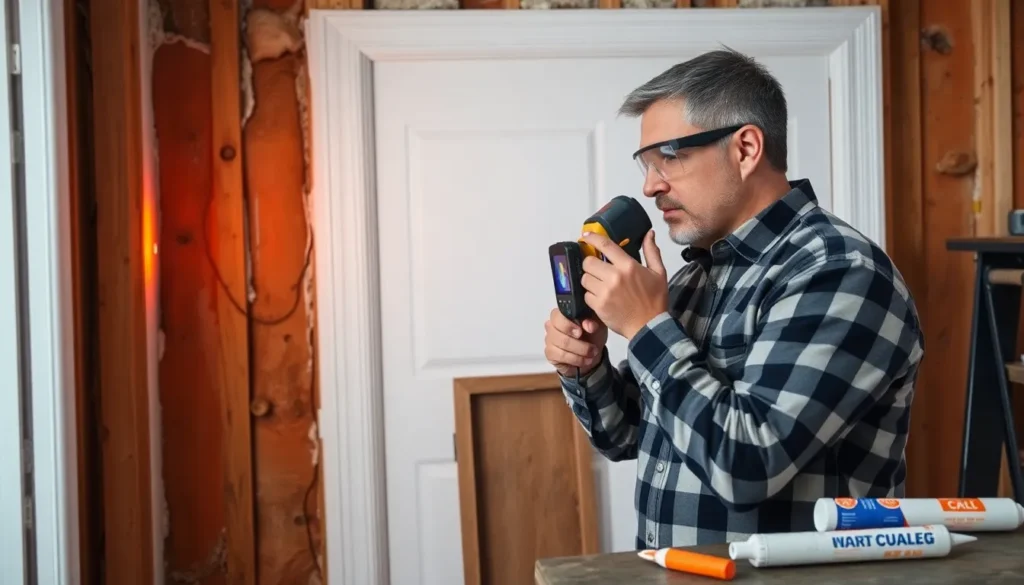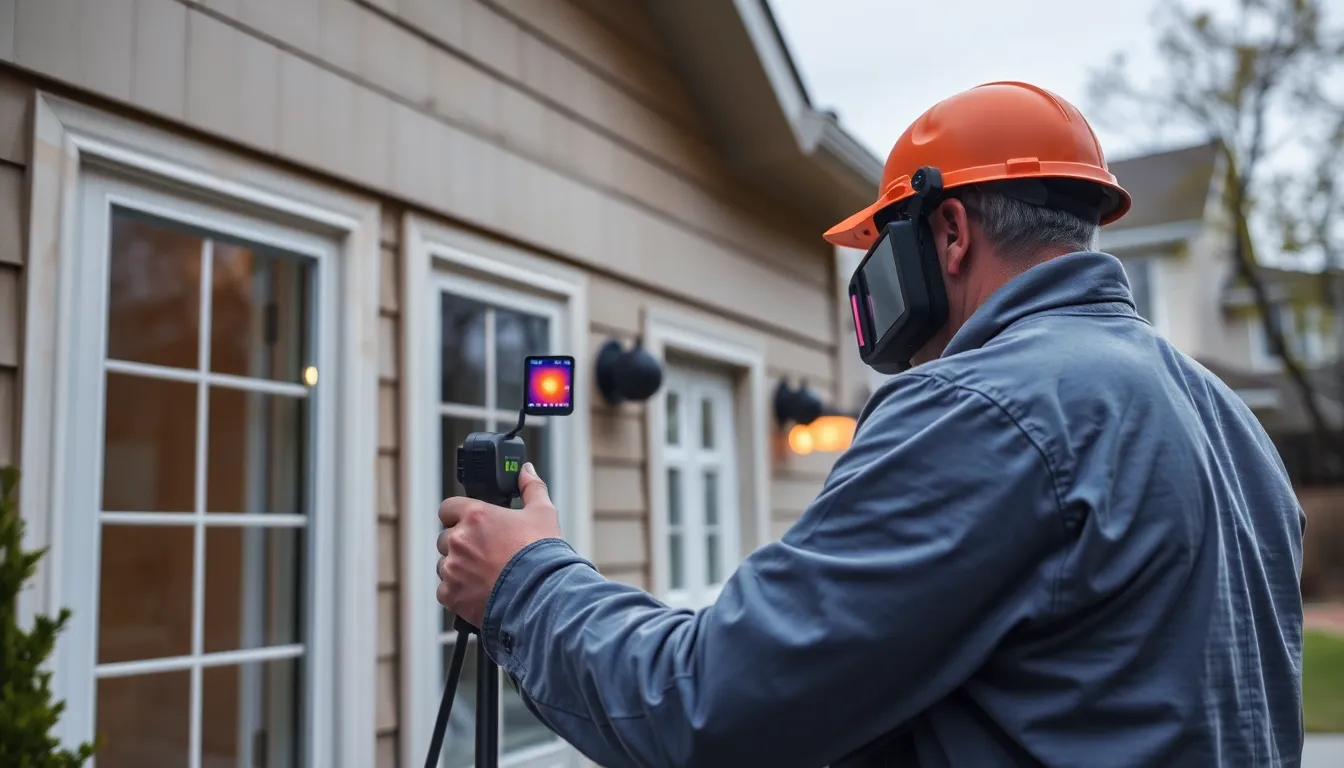Imagine walking into a room and feeling a breeze that shouldn’t be there. That’s not the ghost of drafts past; it’s air leakage wreaking havoc on your comfort and wallet. Air leakage control isn’t just a fancy term for sealing up your home; it’s a superhero move that saves energy, keeps you cozy, and even helps the planet. Who knew sealing those sneaky gaps could be so powerful?
In a world where energy bills are rising faster than a cat can knock over a glass of water, tackling air leakage has never been more crucial. From windows to doors to those pesky little cracks, air leaks can turn your home into a sieve. Let’s dive into the art of air leakage control and discover how a few simple fixes can transform your living space into an energy-efficient fortress.
Table of Contents
ToggleOverview of Air Leakage Control
Air leakage control involves strategies that minimize unwanted air movement in buildings. Creating an airtight environment can enhance comfort significantly while lowering energy costs. In homes, gaps in windows, doors, and walls allow conditioned air to escape. Those leaks can account for 25 to 30 percent of a building’s heating and cooling costs.
Identifying air leaks often starts with visual inspections. Inspectors check commonly problematic areas, including attics, basements, and around electrical outlets. Using a blower door test helps detect leaks by measuring air pressure differences between the inside and outside. This tool is essential for pinpointing locations where air is infiltrating or escaping.
Sealing gaps and cracks improves energy efficiency. Common materials for sealing include caulk, weatherstripping, and foam insulation. Contractors often recommend applying caulk around window frames and door frames, while weatherstripping can improve seals along moving components. Foam insulation fills irregular spaces effectively and provides added thermal resistance.
Regular maintenance ensures that air leakage control measures remain effective. Homeowners must periodically check seals and replace materials that have aged or degraded. Energy audits provide valuable insights into the effectiveness of air sealing efforts and guide future improvements.
Implementing air leakage control not only saves on energy bills but also reduces the environmental footprint of a home. Enhancing energy efficiency contributes to lower greenhouse gas emissions, promoting a healthier planet. By prioritizing air leakage control, homeowners take proactive steps towards sustainable living.
Importance of Air Leakage Control
Air leakage control plays a crucial role in maintaining energy efficiency and improving indoor air quality. Addressing air leaks not only saves on energy costs but also enhances the comfort and well-being of occupants.
Energy Efficiency
Energy efficiency significantly increases when air leakage is controlled. Gaps and cracks in buildings can cause 25 to 30 percent of heating and cooling energy loss. By sealing these leaks, homeowners reduce energy consumption and lower utility bills. Effective air leakage control leads to better temperature regulation, allowing heating and cooling systems to work more efficiently. Increased energy efficiency directly correlates with reduced demand for fossil fuels, contributing to a more sustainable environment. Prioritizing air sealing measures enhances the overall performance of HVAC systems, promoting longevity and reliability.
Indoor Air Quality
Indoor air quality improves with effective air leakage control. Uncontrolled air leaks allow outdoor pollutants, allergens, and humidity to enter indoor spaces. By minimizing these unwanted air movements, occupants experience a healthier living environment. Proper sealing reduces exposure to dust, pollen, and mold, which can affect respiratory health. Enhanced indoor air quality results in fewer health issues, such as asthma and allergies. When fresh air is introduced through controlled ventilation, it promotes comfort without sacrificing energy efficiency. Regular maintenance ensures that sealing materials remain effective over time, keeping indoor environments safe and pleasant.
Techniques for Air Leakage Control
Effective air leakage control methods focus on reducing unwanted air movement throughout homes. Homeowners can implement various strategies to enhance energy efficiency and comfort.
Sealing Methods
Sealing gaps effectively aids in preventing air leakage. Common sealing materials like caulk, weatherstripping, and foam can fill cracks around windows, doors, and other openings. Caulk provides a durable seal for stationary joints, while weatherstripping works well for movable parts, like doors and windows. Foam insulation expands upon application, allowing for tight seals in larger gaps. Regularly checking and renewing these sealing materials ensures sustained performance, as they can degrade over time.
Insulation Improvements
Improving insulation contributes significantly to air leakage control. Insulation types include fiberglass, cellulose, and spray foam, each offering varying R-values to enhance thermal resistance. Properly insulating attics, walls, and basements reduces airflow and keeps conditioned air inside. During installation, professionals should ensure there are no voids or compressions, as these can decrease effectiveness. Attention to detail during installation and maintenance maximizes energy efficiency, helping homeowners lower heating and cooling costs.
Tools and Technologies
Various tools and technologies facilitate effective air leakage control, enhancing energy efficiency in homes. Employing these methods ensures a comprehensive approach to identifying and addressing leaks.
Blower Door Testing
Blower door testing involves using specialized equipment to measure air leakage. This process identifies gaps by pressurizing or depressurizing the home, allowing for accurate assessments. A fan is mounted in an exterior door frame to control air movement, revealing air leak locations. Often, this test highlights routes where up to 30 percent of heating and cooling energy escapes, making it a crucial component of energy audits. Following the test, homeowners obtain data that guides sealing and insulation efforts.
Infrared Thermography
Infrared thermography uses thermal imaging technology to visualize temperature differences across surfaces. This method identifies unsealed areas, including windows and doors, which may otherwise go unnoticed. Capturing thermal images allows for quick analysis of heat loss and air movement patterns. Detecting cold spots signals potential leaks, leading to targeted repairs. By utilizing this technology, homeowners gain valuable insights into energy efficiency and can optimize their sealing strategies accordingly.
Common Challenges
Identifying air leaks remains a fundamental challenge for homeowners. Visual inspections often miss smaller openings. Blower door tests provide a more detailed approach by pressurizing or depressurizing the home, revealing gaps that are otherwise undetectable.
Sealing materials also present challenges. For instance, homeowners may face difficulties choosing the appropriate product for specific joints. Caulk works well for stationary gaps, while weatherstripping is ideal for movable parts like doors and windows. Foam insulation fills larger voids, yet improper application can lead to less effective sealing.
Time and effort required for sealing can also discourage homeowners. Significant amounts of air leakage occur in hard-to-reach areas, making repairs more complex. Achieving comprehensive sealing takes careful planning and can mean dealing with areas that often attract contaminants.
Building codes and standards might add another layer of complexity. Navigating these regulations necessitates understanding local requirements, which can vary widely. Misinterpretation can lead to non-compliance, resulting in added costs and delays.
Additionally, seasonal climate variations impact air leakage issues. Cold temperatures can cause materials to contract, while heat can cause expansion. Addresses air leaks effectively must account for these fluctuations.
Overall, air leakage control poses various challenges. Understanding the specific properties and behaviors of sealing materials, alongside local regulations and seasonal changes, simplifies effective air leak management and enhances energy efficiency in homes.
Best Practices for Implementation
Implementing air leakage control effectively requires a systematic approach. Start with an intensive inspection of potential leak sources like windows, doors, and gaps in the walls. Common tools for this inspection include infrared thermography and blower door tests, which provide valuable insights into air leakage.
Use specific sealing materials based on the nature of the joints. Caulk works well for stationary joints, while weatherstripping suits movable components like doors. Foam insulation offers additional thermal resistance, effectively addressing larger gaps.
Prioritize sealing gaps around plumbing and electrical penetrations, as these areas frequently contribute to energy loss. Sealant application must be thorough to ensure no air escapes, especially in hard-to-reach spaces. Many homeowners overlook these crucial details, yet addressing them significantly enhances overall energy efficiency.
Schedule regular maintenance and energy audits to monitor the effectiveness of sealing efforts. These audits help identify any new leaks that may develop over time. Keeping a proactive maintenance schedule ensures continued improvement in energy savings.
Engage professional services if necessary. Certified energy auditors possess expertise in identifying and addressing hard-to-find leaks, especially in complex building systems. For significant air leakage issues, consulting with HVAC professionals can lead to tailored solutions that enhance comfort and efficiency.
Stay informed on local building codes and seasonal requirements. Understanding regulations helps ensure compliance while achieving optimal energy performance. Adapt strategies based on seasonal variations to maintain comfort and efficiency year-round.
Conclusion
Effective air leakage control is essential for creating comfortable and energy-efficient homes. By addressing gaps and leaks homeowners can significantly lower energy costs while improving indoor air quality. Utilizing techniques like sealing with caulk and weatherstripping not only enhances thermal resistance but also prolongs the life of HVAC systems.
Regular inspections and maintenance are key to ensuring that sealing efforts remain effective over time. Homeowners should consider professional assessments to identify hard-to-detect leaks and make informed decisions on sealing materials. Ultimately, investing in air leakage control contributes to a healthier living environment and supports sustainable practices, making it a worthwhile endeavor for any homeowner.










